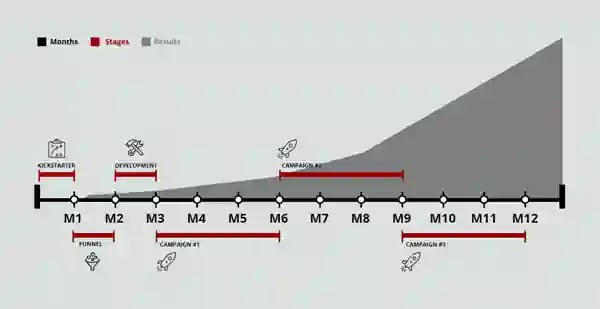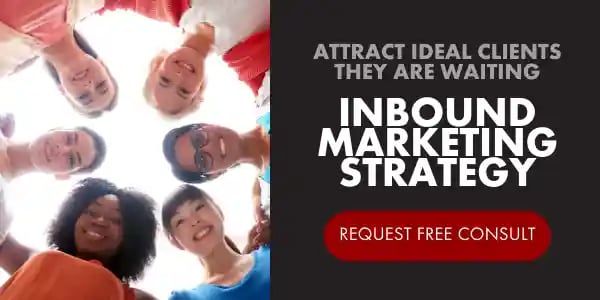Intro
This is certainly a question that we get asked all the time and a very important one at that. The truth is, it depends on the type of results you want.
While engagement matters, we focus on the results that move sales forward to increase revenue.
Keep reading to see the type of results we deliver and how long it typically takes to see them.
What results are we looking for?
For our inbound retainer clients, we track and report on three KPIs (key performance indicators). traffic, leads, and sales.
For all of our other clients, we will track what applies as part of our project or retainer agreement.
For example, if a client asks us to redesign their site; but doesn’t hire us to get them more traffic, then we would not track traffic. We would recommend benchmarking the site to see how it converts visitors to leads in comparison to the previous design.
Traffic
Traffic is typically the first result we can deliver. On average, our clients see an increase in traffic within days of starting a campaign.
Our expectation is to see an increase within the first 30 days. Increasing traffic is our first step towards getting more sales.
When we look at traffic, we consider the amount of traffic as well as the quality of the traffic. Once we reach our goal for sessions per month, we continually work to increase the quality of the traffic.
Leads
The second result we work towards is converting traffic into leads. For our inbound retainer clients; we typically start to see our first leads between three and six months of working together.
Much like traffic, we are trying to reach a number of leads per month, then continue working to improve the quality of the leads coming in.
Sales
The last result we track is sales. Ultimately, this is what we want most for our clients, an increase in sales.
This is also the one that is a little outside of our control as it’s codependent on our client’s ability to close sales.
Our clients that respond to leads within the first hour see the most success closing sales. On average, our clients close their first new deal between 4 and 8 months.
Where does engagement fit in?

Likes, comments, shares, and follows are metrics that certainly shouldn’t be ignored, but they play a different role. They are great for measuring how your social posts are performing and to increase your impressions or reach.
On most social platforms, the more engagement you get, the more people will see your posts. Basically, social platforms think it’s good to show content people already like to more people that may like the same content.
Our recommendation is to measure each of these metrics, but don’t let them distract you from your primary revenue goals. These are not guaranteed metrics for determining how soon you will see an increase in traffic, leads, and sales.
What can slow down results?
There are many things that can slow down or diminish results. We’ll share some of the more common roadblocks our clients face.
Undervalued Strategy
In our experience, the number one reason businesses see results slower than others is when they don’t truly buy-in and commit to mapping out a clear strategy.
We can often tell clients undervalue strategy when they push to skip steps, or just check-off boxes to start trying to accelerate past the planning process. A typical example of this is skipping over defining and creating personas.
Slow, Or No Delivery
This is most common when clients decide to write or create content in-house instead of outsourcing it. Sometimes clients underestimate how important the content is to a project.
In most inbound campaigns leads are generated by providing an offer, like an eBook or webinar, in exchange for contact information. If a client is responsible for creating the offer but delivers it late, then it will naturally delay the ability to convert leads.
Low, Or No Budget
While organic SEO is the better, long play for ROI, paid traffic is the fastest way to start getting results. Not having a budget for paid ads puts you 100% at the mercy of your organic results. This means you’ll need to write more blog posts and share more content across social channels in addition to your ongoing SEO strategy.
What We Typically See.
Here’s a chart to illustrate when we typically start to see results on average for our clients.

You see that we typically expect to see some results in early stages, but the results typically improve over time.
In Closing… Your Results May Vary.
To simply answer your question; your results may vary. The key is to make sure that you are:
- looking for the right results,
- utilizing the proper tools to track results,
- and not sabotaging your ability to see and track your desired results.
If you do this you will have the data you need to make data-informed decisions for your business.
Next Steps
There are a few things you can do to prepare to track your results. Take a look at the list below.
- Align your KPIs to the appropriate strategies and desired results
- Audit your current tracking & reporting tools.
- Look for any bottlenecks that are slowing you down.
If you need a little help with benchmarking, tracking or reporting we can help. Schedule a 15-minute call to learn how we can help you close the loop on reporting your ROI.



